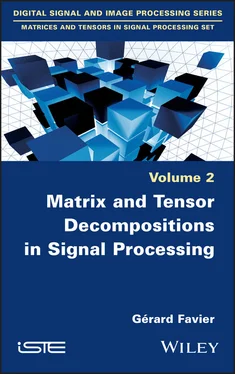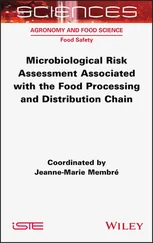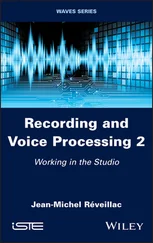– use of tensor decompositions to analyze biomedical signals (EEG, MEG, ECG, EOG 4) in the space, time and frequency domains, in order to provide a medical diagnostic aid; for instance, Acar et al. (2007) used a PARAFAC model of EEG signals to analyze epileptic seizures; Becker et al. (2014) used the same type of decomposition to locate sources within EEG signals;
– analysis of brain activity by merging imaging data (fMRI) and biomedical signals (EEG and MEG) with the goal of enabling non-invasive medical tests (see Table I.4);
– analysis and classification of hyperspectral images used in many fields (medicine, environment, agriculture, monitoring, astrophysics, etc.). To improve the spatial resolution of hyperspectral images, Li et al. (2018) merged hyperspectral and multispectral images using a coupled Tucker decomposition with a sparse core (coupled sparse tensor factorization (CSTF)) (see Table I.4);
– design of semi-blind receivers for point-to-point or cooperative MIMO communication systems based on tensor models; see the overviews by de Almeida et al. (2016) and da Costa et al. (2018);
– modeling and identification of nonlinear systems via a tensor representation of Volterra kernels or Wiener–Hammerstein systems (see, for example, Kibangou and Favier 2009a, 2010; Favier and Kibangou 2009; Favier and Bouilloc 2009, 2010; Favier et al. 2012a);
– identification of tensor-based separable trilinear systems that are linear with respect to (w.r.t.) the input signal and trilinear w.r.t. the coefficients of the global impulse response, modeled as a Kronecker product of three individual impulse responses (Elisei-Iliescu et al. 2020). Note that such systems are to be compared with third-order Volterra filters that are linear w.r.t. the Volterra kernel coefficients and trilinear w.r.t. the input signal;
– facial recognition, based on face tensors, for purposes of authentication and identification in surveillance systems. For facial recognition, photos of people to recognize are stored in a database with different lighting conditions, different facial expressions, from multiple angles, for each individual. In Vasilescu and Terzopoulos (2002), the tensor of facial images is of order five, with dimensions: 28 × 5 × 3 × 7943, corresponding to the modes: people × views × illumination × expressions × pixels per image. For an overview of various facial recognition systems, see Arachchilage and Izquierdo (2020);
– tensor-based anomaly detection used in monitoring and surveillance systems.
Table I.1presents a few examples of signal and image tensors, specifying the nature of the modes in each case.
Table I.1. Signal and image tensors
| Signals |
Modes |
References |
| Antenna processing |
space (antennas) × time × sensor subnetwork space × time × polarization |
(Sidiropoulos et al . 2000a) (Raimondi et al . 2017) |
| Digital communications |
space (antennas) × time × code antennas × blocks × symbol periods × code × frequencies |
(Sidiropoulos et al . 2000b) (Favier and de Almeida 2014b) |
| ECG |
space (electrodes) × time × frequencies |
(Acar et al . 2007; Padhy et al . 2019) |
| EEG |
space (electrodes) × time × frequencies × subjects or trials |
(Becker et al . 2014; Cong et al . 2015) |
| EEG + fMRI |
subjects × electrodes × time + subjects × voxels (model with matrix and tensor factorizations coupled via the “subjects” mode) |
(Acar et al . 2017) |
| Images |
Modes |
References |
| Color images |
space (width) × space (height) × channel (colors) |
|
| Videos in grayscale |
space (width) × space (height) × time |
|
| Videos in color |
space × space × channel × time |
|
| Hyperspectral images |
space × space × spectral bands |
(Makantasis et al . 2018) |
| Computer vision |
people × views × illumination × expressions × pixels |
(Vasilescu and Terzopoulos 2002) |
Other fields of application are considered in Table I.2.
Below, we give some details about the application concerning recommendation systems, which play an important role in various websites. The goal of these systems is to help users to select items from tags that have been assigned to each item by users. These items could, for example, be movies, books, musical recordings, webpages, products for sale on an e-commerce site, etc. A standard recommendation system is based on the three following modes: users × items × tags .
Collaborative filtering techniques use the opinions of a set of people, or assessments from these people based on a rating system, to generate a list of recommendations for a specific user. This type of filtering is, for example, used by websites like Netflix for renting DVDs. Collaborative filtering methods are classified into three categories, depending on whether the filtering is based on (a) history and a similarity metric; (b) a model based on matrix factorization using algorithms like SVD or non-negative matrix factorization (NMF); (c) some combination of both, known as hybrid collaborative filtering techniques. See Luo et al . (2014) and Bokde et al . (2015) for approaches based on matrix factorization.
Other so-called passive filtering techniques exploit the data of a matrix of relations between items to deduce recommendations for a user from correlations between items and the user’s previous choices, without using any kind of rating system. This is known as a content-based approach.
Table I.2. Other fields of application
| Domains |
Modes |
References |
| Phonetics |
subjects × vowels × formants |
(Harshman 1970) |
| Chemometrics (fluorescence) |
excitation × emission × samples (excitation/emission wavelengths) |
(Bro 1997, 2006; Smilde et al . 2004) |
| Contextual recommendation systems |
users × items × tags × context 1 × • • • × context N |
(Rendle and Schmidt-Thieme 2010) (Symeonidis and Zioupos 2016) (Frolov and Oseledets 2017) |
| Transportation (speed measurements) |
Space (sensors) × time (days) × time (weeks) (periods of 15s and 24h) |
(Goulart et al . 2017) (Tan et al . 2013; Ran et al . 2016) |
| Music |
types of music × frequencies × frequencies users × keywords × songs recordings × (audio) characteristics × segments |
(Panagakis et al . 2010) (Nanopoulos et al . 2010) (Benetos and Kotropoulos 2008) |
| Bioinformatics |
medicine × targets × diseases |
(Wang et al . 2019) |
Recommendation systems can also use information about the users (age, nationality, geographic location, participation on social networks, etc.) and the items themselves (types of music, types of film, classes of hotels, etc.). This is called contextual information. Taking this additional information into account allows the relevance of the recommendations to be improved, at the cost of increasing the dimensionality and the complexity of the data representation model and, therefore, of the processing algorithms. This is why tensor approaches are so important for this type of application today. Note that, for recommendation systems, the data tensors are sparse. Consequently, some tags can be automatically generated by the system based on similarity metrics between items. This is, for example, the case for music recommendations based on the acoustic characteristics of songs (Nanopoulos et al . 2010). Personalized tag recommendations take into account the user’s profile, preferences, and interests. The system can also help the user select existing tags or create new ones (Rendle and Schmidt-Thieme 2010).
Читать дальше












